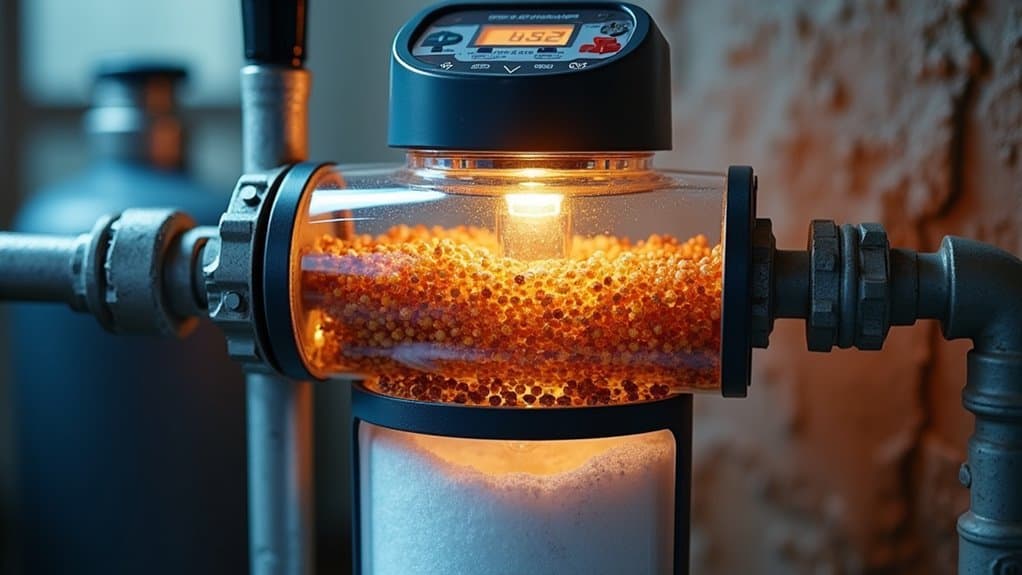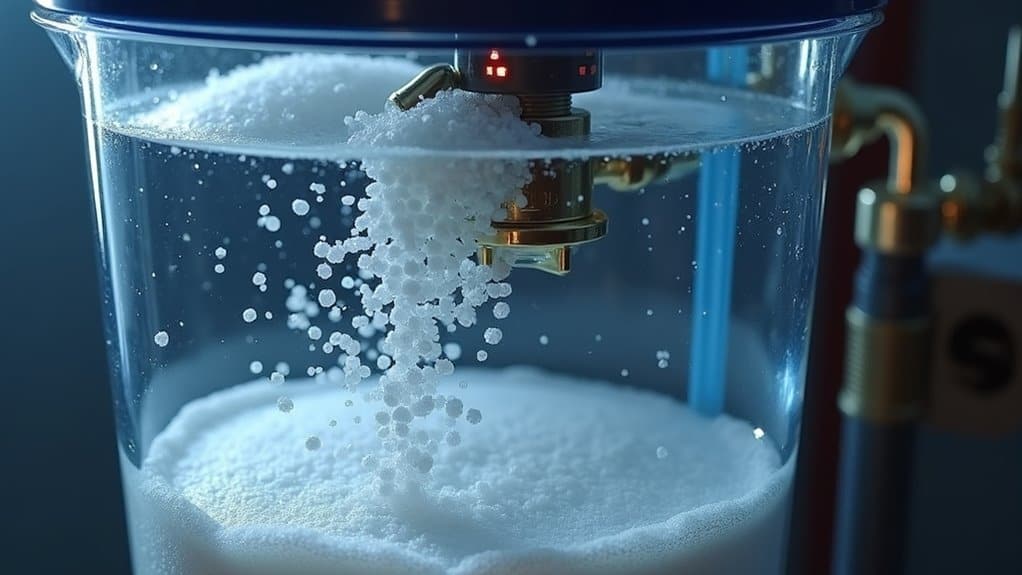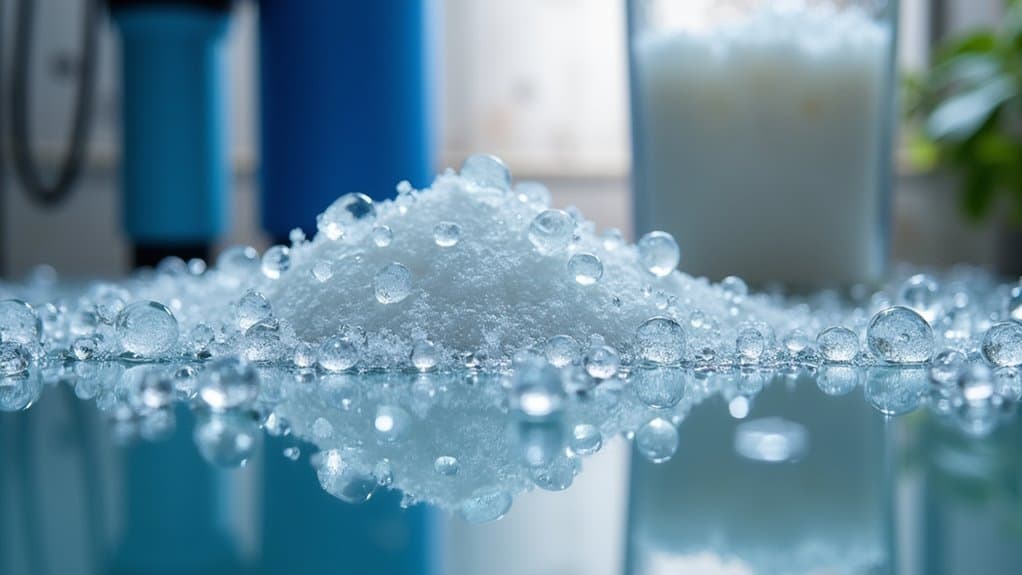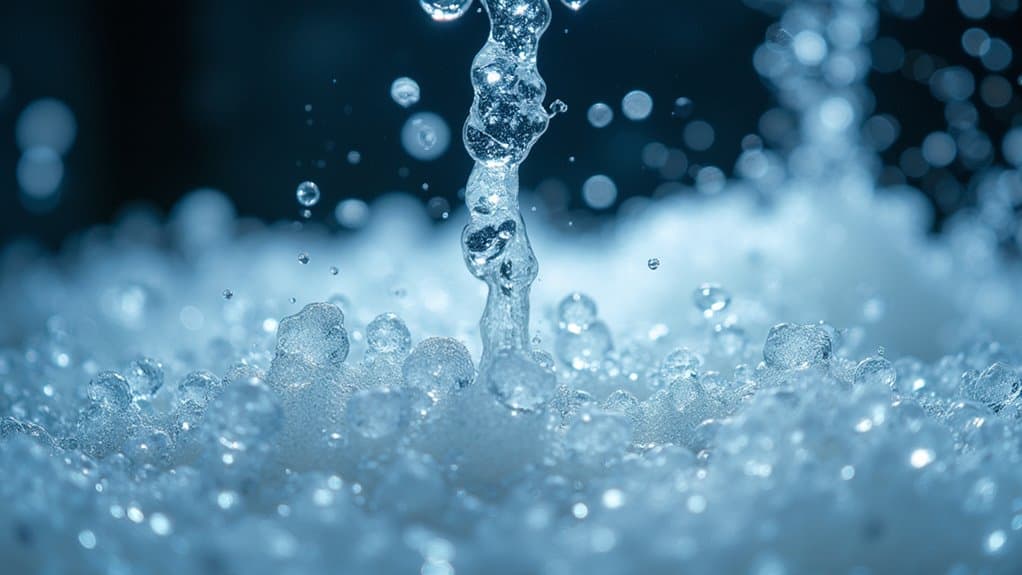Water softeners work through a clever ion exchange process where sodium-coated resin beads attract and trap calcium and magnesium ions (the culprits behind hard water), while releasing sodium ions in return. When these beads get saturated, a brine solution flushes through during regeneration, washing away captured minerals and recharging the resin. This simple yet effective mechanism extends appliance life, improves soap lathering, and prevents scale buildup. The financial benefits might surprise you.
Key Takeaways
- Resin beads trap calcium and magnesium ions from hard water while releasing sodium ions in exchange.
- Water softeners undergo regeneration cycles using saltwater to flush out captured minerals and recharge the resin.
- The process prevents scale buildup that would otherwise reduce appliance efficiency by up to 30%.
- A typical system consumes 35-70 gallons of water during regeneration for a family of four.
- Modern water softeners can intelligently monitor water usage to determine optimal regeneration timing.
The Sneaky Science Behind Ion Exchange That Softens Your Water

While many homeowners simply enjoy the benefits of softer water, they rarely understand the electrochemical dance happening inside their water softeners.
We’re witnessing a sophisticated ion exchange mechanism. Resin beads coated with sodium ions attract calcium and magnesium through electrostatic bonds. As water flows through the resin bed, these hardness minerals adhere to the beads, displacing sodium ions into solution. The process typically removes nearly all calcium and magnesium from the source water, dramatically improving water quality. This process is essential because hard water minerals can lead to buildup and damage in plumbing systems over time.
Eventually, the resin becomes saturated with Ca²⁺ and Mg²⁺ ions, triggering regeneration. A brine solution flushes through, restoring sodium ions and expelling captured minerals.
This cycle repeats based on water hardness and usage rates.
Inside Your Water Softener: Key Components Behind the Magic

Although the ion exchange process may seem like wizardry, a water softener’s effectiveness relies on several interdependent components working in harmony.
At the system’s heart lies the resin tank. It contains specialized beads coated with sodium or potassium ions that attract calcium and magnesium minerals through ion exchange.
A critical riser tube channels the newly softened water upward to the head valve for distribution throughout your home. The brine injector draws salt solution into the resin tank during regeneration cycles, helping restore the sodium ions on the resin.
To prevent resin bead escape, the tank utilizes a basket filtration system. Over time, these beads require maintenance—either cleaning or replacement—to maintain optimal performance.
We’ll explore the regeneration cycle next.
The Regeneration Cycle: How Your System Rejuvenates Itself

When the resin beads in your water softener become saturated with calcium and magnesium ions, they can no longer effectively soften your water, triggering what we call the regeneration cycle.
During regeneration, the system reverses the ion exchange process that occurred during normal operation. A brine solution flows through the resin bed, where sodium ions displace the accumulated calcium and magnesium. This effectively reactivates the resin beads, restoring their capacity to remove hardness minerals. This entire process typically consumes between 35-70 gallons of water for an average family of four. Additionally, during this cycle, the system can also help to reduce scale buildup in your plumbing, which can prolong the life of your pipes and appliances.
The timing of this rejuvenation process varies by system design—some units regenerate on a preset schedule, while others monitor actual water usage to initiate regeneration only when necessary, optimizing salt efficiency.
Beyond Clean Dishes: The Surprising Benefits of Soft Water

Soft water delivers significant advantages across multiple areas. For personal care, it enhances soap lather, prevents residue on skin, and improves hair texture while reducing eczema and scalp flakiness. Additionally, many people have reported that improved water quality can lead to a noticeable reduction in skin irritations and dryness.
Throughout your home, it eliminates mineral spots and reduces cleaning frequency by preventing stubborn deposits. Hard water can cause reduced water pressure in your plumbing system as minerals accumulate in pipes.
Your appliances benefit too—water heaters, washing machines, and plumbing systems experience extended lifespans due to prevented scale buildup.
Perhaps most compelling are the financial benefits: appliances operate 30% more efficiently, and you’ll use significantly less detergent and cleaning products.
Frequently Asked Questions
Do Water Softeners Remove Beneficial Minerals From Drinking Water?
Yes, we remove calcium, magnesium, and sometimes iron from water through ion exchange, but these minerals aren’t critical to your diet since you get them primarily from food sources.
Can Softened Water Damage Plants or Lawns?
Yes, we’ve found softened water can harm plants and lawns over time. The sodium accumulation disrupts soil structure, causes nutrient leaching, and creates toxic conditions that stunt growth and diversity.
How Much Does a Water Softener Increase Sodium Intake?
We’ll consume approximately 28mg of sodium per 8oz cup of softened water at 15 grains hardness. This contributes about 4-7% to our daily sodium intake with typical consumption levels.
Are Salt-Free Water Conditioners Effective Alternatives to Traditional Softeners?
We find salt-free conditioners effective for mild hardness (below 10 gpg), but they don’t remove minerals like traditional softeners. They prevent scale without adding sodium, though they’re less effective with soap performance.
How Do Water Softeners Impact Septic Systems?
We’ve found that properly sized water softeners pose minimal harm to septic systems. However, inefficient units can cause hydraulic overload, sodium buildup, and disrupt bacterial activity during regeneration cycles.
Conclusion
We’ve explored how water softeners function through ion exchange, replacing calcium and magnesium with sodium ions. The system’s components—resin beads, brine tank, and control valve—work together to effectively remove hardness minerals. The regeneration cycle ensures continuous performance through backwashing, recharging, and rinsing phases. By implementing this technology, we’ll experience benefits beyond cleaner dishes: extended appliance life, reduced soap usage, and healthier skin and hair.

Craig “The Water Guy” Phillips is the founder of Quality Water Treatment (QWT) and creator of SoftPro Water Systems.
With over 30 years of experience, Craig has transformed the water treatment industry through his commitment to honest solutions, innovative technology, and customer education.
Known for rejecting high-pressure sales tactics in favor of a consultative approach, Craig leads a family-owned business that serves thousands of households nationwide.
Craig continues to drive innovation in water treatment while maintaining his mission of “transforming water for the betterment of humanity” through transparent pricing, comprehensive customer support, and genuine expertise.
When not developing new water treatment solutions, Craig creates educational content to help homeowners make informed decisions about their water quality.


